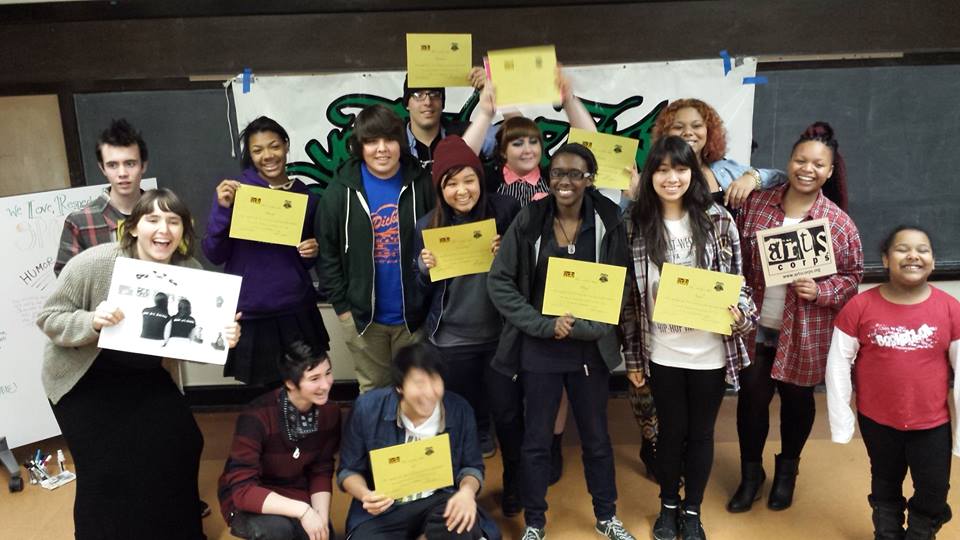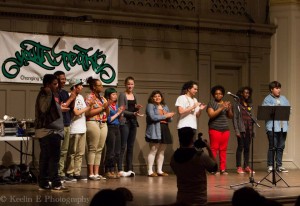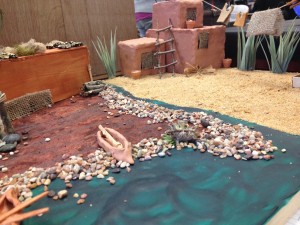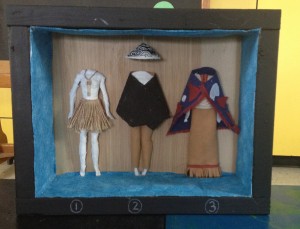 I’m pretty sure that Seattle doesn’t want to admit that summer is over. It seems like we are all reluctantly clutching rain jackets and umbrellas, peering out bus windows to see if we can guess what season the afternoon weather will resemble. Fall is a strange transition. Sometimes it feels like equal parts renewal and rot, a beginning and an ending in one breath. The trees are letting go of their leaves. Students are trudging through them to begin the school year. The cycle begins again and our sunset times slide earlier and earlier. As I dive into my second year as an AmeriCorps at Arts Corps and Youth Speaks Seattle, it feels like the perfect season for reflection and recommitment. Indeed, on the Jewish Calendar, we are smack dab in the middle of a time called the Days of Awe. This period of introspection stretches from Rosh Hashannah (Jewish New Year) and Yom Kippur (the Day of Atonement). As part of a personal recommitment to my Jewish tradition, I’ve been welcoming in 5775 with ritual, community and apples and honey.
I’m pretty sure that Seattle doesn’t want to admit that summer is over. It seems like we are all reluctantly clutching rain jackets and umbrellas, peering out bus windows to see if we can guess what season the afternoon weather will resemble. Fall is a strange transition. Sometimes it feels like equal parts renewal and rot, a beginning and an ending in one breath. The trees are letting go of their leaves. Students are trudging through them to begin the school year. The cycle begins again and our sunset times slide earlier and earlier. As I dive into my second year as an AmeriCorps at Arts Corps and Youth Speaks Seattle, it feels like the perfect season for reflection and recommitment. Indeed, on the Jewish Calendar, we are smack dab in the middle of a time called the Days of Awe. This period of introspection stretches from Rosh Hashannah (Jewish New Year) and Yom Kippur (the Day of Atonement). As part of a personal recommitment to my Jewish tradition, I’ve been welcoming in 5775 with ritual, community and apples and honey.
The Days of Awe, with their sweetness and reflection, feel like prime time to set intentions for my second year as Teen Artist Program Co-Coordinator. This is the season to ask: what lessons, tensions and celebrations do I have from the previous year? What were our sweetest successes? Where do we have room to grow? The highlights aren’t hard to remember – last year was hectic but bursting with growth and excitement. We continued the YSS legacy with the fierce All-City Poetry Slam Series and ongoing open mics and writing circles. In addition, we expanded the historic Spokes Leadership board by launching the first ever Arts Liberation and Leadership Institute (ALLI). Twelve youth artists went through this 10-week institute focusing on community organizing, artistry and social justice. With ALLI as their foundation, these twelve Spokes helped to organize, facilitate and outreach for Youth Speaks Seattle and Teen Artist Program events from December to May. By May, we began preparing with YSS slam team for Brave New Voices (BNV), the International Youth Poetry Slam Festival. From May to July, the 5-poet team wrote, practiced, collaborated and built a loving slam fam, before jetting off to Philly for BNV in mid-July. Co-coaching the team with YSS alum, mentor and badass Troy Osaki, I got to end my first term of service with this amazing adventure.
 Reflecting on the year, I’m truly in awe of the transformation I witnessed in individual poets and artists. Shy and reluctant poets began to hit the mic with vulnerability and raw power. New organizers took to the streets and the hallways to outreach for Youth Speaks Seattle and Arts Corps. Some folks started the year scared to speak in public and ended it facilitating an entire workshop on songwriting. Talented performers cultivated their skills as teaching artists and finished the year booking their own teaching gigs. I’m excited to see how these individual growths can mirror our organizational visions for a more just future.
Reflecting on the year, I’m truly in awe of the transformation I witnessed in individual poets and artists. Shy and reluctant poets began to hit the mic with vulnerability and raw power. New organizers took to the streets and the hallways to outreach for Youth Speaks Seattle and Arts Corps. Some folks started the year scared to speak in public and ended it facilitating an entire workshop on songwriting. Talented performers cultivated their skills as teaching artists and finished the year booking their own teaching gigs. I’m excited to see how these individual growths can mirror our organizational visions for a more just future.
As I return this Fall, I wish to use my reflection as a springboard for recommitment. This past weekend, I attended a Jewish ritual called tashlich. Traditionally, tashlich is a Rosh Hashannah practice where Jews symbolically cast our sins away by throwing bread crumbs or pebbles into a body of water. At this particular tashlich, organized by the Jewish Voice for Peace, our casting away was politicized around recommitment to movements for justice. Rather than simply throwing away our “sins”, we were asked to transform their energy into working in the new year towards collective liberation. Rooted in this practice of looking back as a way to move forward, I come to the new year with intention and dedication. I wish to begin this year as my whole self, trusting that we have the time and space to spark another bountiful year at Youth Speaks Seattle and Arts Corps. L’Shanah Tovah and Onwards!
– Shelby
Teen Artist Program Co-Coordinator
Read More





